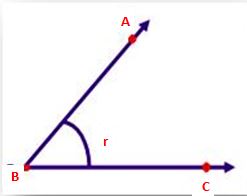The angle is defined as a figure formed by two rays meeting at a common endpoint. Learn Angle Definition, Parts of an angle, Measure of an angle, etc., Learn the complete concept of an angle along with sample examples. We have explained every part of an angle clearly in this article. Angle denotes with the symbol ‘∠’.

The name of the angle is ∠ABC or ∠CAB
Parts of an Angle
Arms: The two rays that are interset each other to form an angle are called Arms of an angle. From the above-given figure, BA and BC are the arms of the Angle ABC.
Vertex: The endpoint where two arms of an angle interest each other is called the vertex. From the given figure, point B is the vertex of Angle ABC.
Size of an Angle: The amount of turn from one arm of the angle to the other arm of the angle is said to be the size of an angle. The size of the angles represents in degrees. The symbol is º.
Types of Angles
There are different types of angles available based on the measure of an angle. They are,
- Acute Angle
- Obtuse Angle
- Right Angle
- Straight Angle
- Reflex Angle
- Full Rotation
1. Acute Angle: An angle that forms less than 90 degrees is called an acute angle. The measure of an acute angle is between 0º and 90º.
2. Obtuse Angle: An angle that forms greater than 90 degrees is called an Obtuse angle. The measure of an Obtuse angle is between 90º and 180º.
Obtuse Angle Measure = (180 – acute angle measure)
3. Right Angle: An angle that forms exactly 90 degrees is called a right angle. The measure of a right angle is exactly 90º. The two lines are perpendicular to each other at the right angle.
4. Straight Angle: The angle that forms 108º is called the Straight Angle.
5. Reflex Angle: An angle that forms greater than 180 degrees and less than 360 degrees is called a Reflex angle.
6. Full Rotation: The angle that forms 360º called Full Rotation.
Interior and Exterior Angles
In a polygon such as quadrilateral, triangle, hexagon, pentagon, etc., the interior and exterior angles are formed. Interior angles formed inside the polygon or a closed shape. Exterior angles formed outside the given shape.
Positive & Negative Angles
An Angle that calculated in an Anti-Clockwise direction is called a Positive Angle and an angle Clockwise direction is called a Negative Angle.
Angle Measurement
The angle is measured in degrees. The degree symbol is º.
Degree of an Angle
The full angle is 360. Firstly, the full angles are divided using the angle of an equilateral triangle. If the angle is 1, then it is 1/360 of the full rotation. The degree is divided into minutes and seconds.
1°= 60′ = 3600”
Radian of an Angle
The SI unit of angle is the radian of an angle. The Radian of an Angle used in Calculus. All the derivatives and integrals are calculated in the terms of a radian. The radian of an angle is denoted by ‘rad’.
Example: In a complete circle, there are 2π radians available.
360 = 2π; radian
Therefore, 1 radian = 180°/π
Gradian of an Angle
Gradian of an Angle is also called a grade or a gon. The angle is equal to 1 gradian if the rotation starts and moved up to 1/400 of the full rotation. It is denoted by ‘grad’.
Frequently Asked Questions on Angles
1. What is an angle?
The angle is formed by intersecting two rays at a single point. The two rays are called the sides of an angle and the common point is called the vertex.
2. What are the six types of angles?
There are six types of angles. They are
- Acute angle
- Obtuse angle
- Right angle
- Straight angle
- Reflex angle
- Full rotation
3. How angles are calculated?
The angles are calculated with the degree.
4. What is a zero angle?
An angle that consists of zero degree is called zero angle.